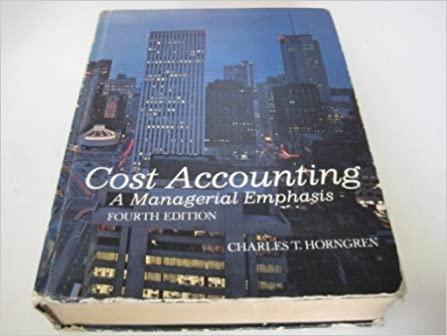Ford Motor Companys Flexible-Budget Control over Clerical Costs Through Work Measurement This case illustrates a method by
Question:
Ford Motor Company’s Flexible-Budget Control over Clerical Costs Through Work Measurement This case illustrates a method by which flexible-budget controls have been adapted to a nonmanufacturing operation to control costs that might normally be classed as fixed labor and operating expense. It is possible and practical to control many expenses of this nature by the use of “standard”
processing rates for work performed.
The following information is presented as background material to outline the control approach followed by this company:
The parts and accessories division of the Ford Motor Company controls and evaluates the performance of its branch-warehouse operations by the use of “flexible labor and expense budgets.” These budgetary controls are in use in both the warehousing and the accounting activities of these operations and are used for both weekly and monthly analysis.
Primarily, variable-labor functions and controllable-expense classifications are supervised in this manner. Fixed costs that are not controllable by local management, such as supervision, taxes, and depreciation, are administered by the use of fixed (static) budget allowances.
All variable functions of the warehousing and accounting activities have been analyzed and standardized and related to some measurable work output.
By maintaining daily control of these functional productivities and related daily labor charges, the required operating reports are prepared and submitted to the general office for analysis, consolidation, and comparison to national operating-budget levels.
A primary source of output statistics is obtained from a record of actual daily shipments made by the warehouse, as many accounting-function productivities are based on this measurement. The determinable output measurements are compared to the predetermined functional-budget rate to calculate
“budget hours generated” during the budget period under review. The operating variances are determined by comparing generated budget hours to actual functional-labor charges during the same period. These variances are expressed both in hours of variance and equivalent-persons variance. The latter variance is calculated by comparing the hourly variance amounts to the forty shifthours available in the budget period under review.
For a recent normal workweek of five operating days, the following output information and labor-distributiOn detail have been accumulated for certain selected accounting-department functions. The complete budget review is actually applied to approximately fifty separate and distinct activities in this operation.
OUTPUT STATISTICS 1. Number of orders shipped 8,640 2. Number of line items* shipped 99,280 3. Number of line items backordered in warehouse 2,720 4. Number of checks written for merchandise received 3,290 5. Number of line items on shipments received 4,960 6. Number of credit adjustments approved 975 *Represents a single part number shipped or received, regardless of quantity.
FUNCTIONAL BUDGET RATES AND LABOR DISTRIBUTION ACTUAL FUNCTION BUDGET RATE PER HOUR HOURS WORKED Invoice scheduling 135 orders shipped 68.0 Keypuncht 680 line items processed 142.0 Keyverification* 1,360 line items processed 71.0 IBM machine operator 1,020 line items printed 108.0 Proofreading? 510 line items proofread 208.0 Accounts payable: 125.0 Invoice matching 80 line items received ;
Check auditing 70 payments made Credit adjustments 15 adjustments issued 69.0 Budgeted hourly labor rate—$5.00 per hour Actual payroll costs —$2,256.00 + To determine the output allowance, the 2,720 line items backordered should be added to the 99,280 items shipped.
* The 125.0 represents the combined actual hours worked on accounts payable; no subdivision is available for invoice matching and check auditing.
. Determine labor variance by function. Express variance in both hours and equivalent persons.
. Calculate total labor variance in dollars.
. Analyze the total dollar variance as determined in part 2. What portion of this variance was attributable to a labor-price variance and a labor-efficiency variance?
Step by Step Answer:






